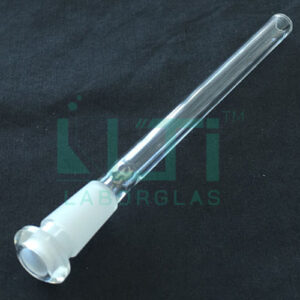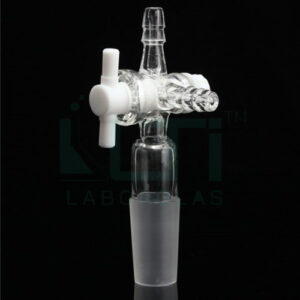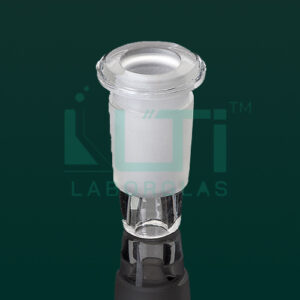- With Drip Tip
- Pear Shape
- Used between flask & condenser to stop movement of raw liquid
| PART No. | NS FEMALE size | NS MALE size | Pack(Qty) |
| 2510-14F14M | 14/23 | 14/23 | 10 |
| 2510-19F24M | 19/26 | 24/29 | 10 |
| 2510-29F29M | 29/32 | 29/32 | 10 |
Here are some common uses for a “Splash Head, Straight” in a laboratory setting:
- Chemical Reactions: When performing chemical reactions that may produce splattering or foaming, a straight splash head can be attached to the neck of the reaction vessel to prevent spills and ensure a controlled environment.
- Distillation Setups: In distillation apparatus, particularly when handling volatile or reactive substances, a splash head can be used to prevent liquid from being carried over into the condenser, which could affect the purity of the distillate.
- Solvent Recovery: When recovering solvents through distillation, a splash head can be employed to control the vapor flow and prevent splashing, ensuring efficient recovery.
- Reflux Setups: In reflux setups, where vapors are condensed and returned to the reaction flask, a splash head can be used to minimize the risk of splattering during the reflux process.
- Heating and Boiling: During heating or boiling procedures, a splash head can be attached to the opening of the vessel to control the release of vapors and prevent splashing.
- Laboratory Filtration: When performing vacuum filtration, a splash head can be used to minimize splashing as the liquid passes through the filter.
- Safety Measures: Splash heads can be used as a safety measure to prevent hazardous substances from splashing or spraying, protecting researchers and maintaining a clean laboratory environment.
- Fractional Distillation: In setups involving fractional distillation, a splash head can be used to control the flow of vapor and liquid, preventing unwanted splashing and ensuring accurate separation of components.





